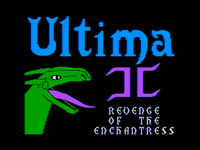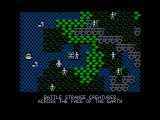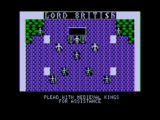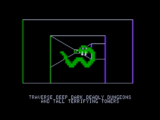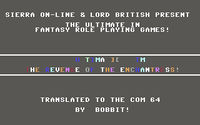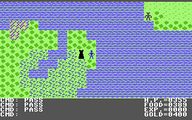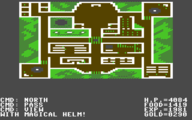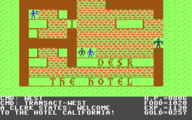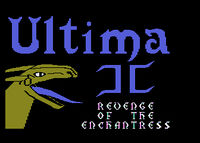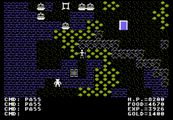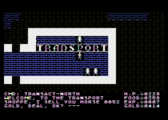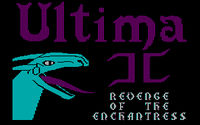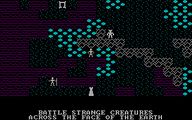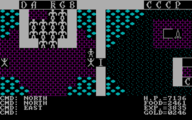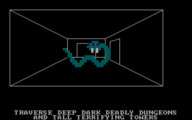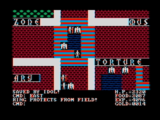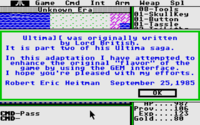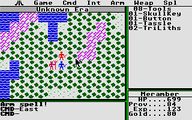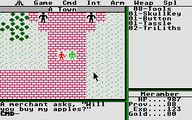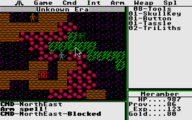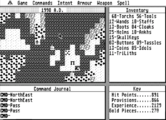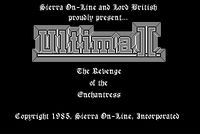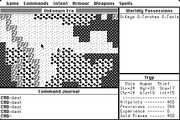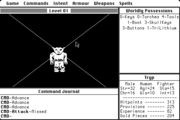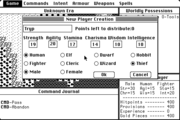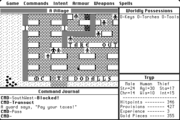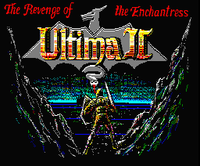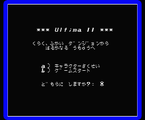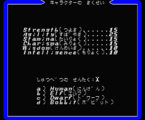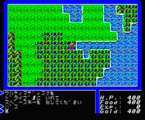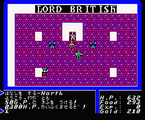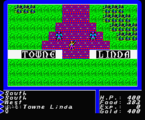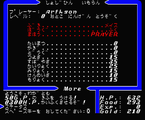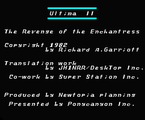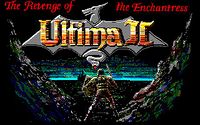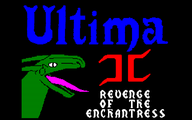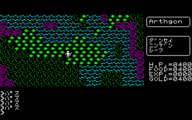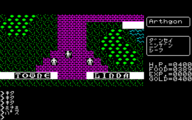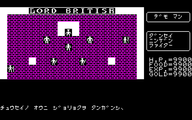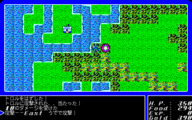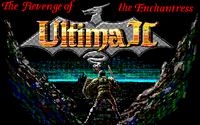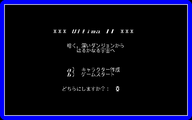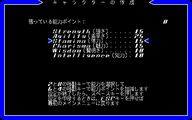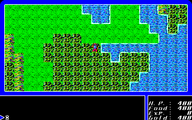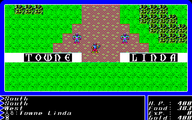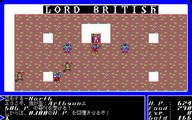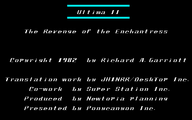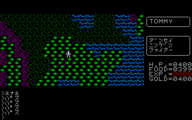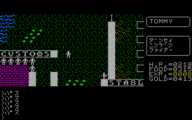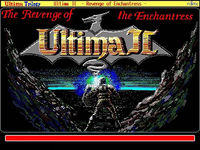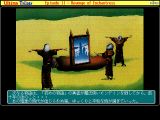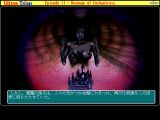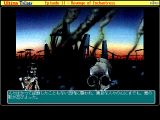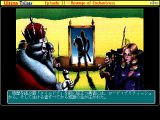Computer ports of Ultima II
Ultima II was the first game of the series to be ported to different systems at the original time of its release (Ultima I was only ported in the re-release). What is noteworthy in the various ports has varied greatly in their presentation of the graphics, with two of them being very different from the rest, unlike ports of later games.
The 8-Bit-Ports[edit]
The Apple II Original[edit]
The original game, on which all the other ports are based.
In the year 1982, the platform of the Apple II was quite powerful, compared to other computers of that time. Graphically, the game looks very similar to Ultima I, with only marginal improvements. However, the programming is much more streamlined compared to the first game and the code, being written in assembly language instead of interpreted BASIC, is at least an order of magnitude faster. It also has an extra animation at the beginning that the other ports lack, where the dragon head appears, and then makes the "Ultima II" title appear in a fire cloud.
Like the first part, the weakness of the graphics are the strange colors, which is especially noticeable in purple brick floors and multi-colored mountains. The game also has various glitches, like the dreaded numbers roll-over, which can make playing very difficult. Especially crippling is the fact that the "Strength" stat can never be raised due to one bug, making fights much harder than originally intended. It also makes the game unwinnable with certain character combinations with too low strength to wear the correct armour for space flight.
A little-known, slightly updated Apple II version was made available in the Ultima Trilogy I II III compilation, distinguished by blue borders around the gameplay/status boxes, a custom text font (that also included lowercase letters) and support for the up and down arrow keys of the Apple IIe and later systems. Only the Apple version of the Trilogy received this update; the Commodore 64 and IBM PC versions contained the original Ultima II for their respective platforms. The Apple update of Ultima II is notable for being the final Origin product to be written for the computer platform where Ultima itself was born.
The game was released on two 5.25" floppy disk.
The C64-Port[edit]
The port for the C64, made by Bob 'Bobbit' Heitman, is surprising, since it looks quite different from the other 1982 ports.
In the Apple II, IBM, and Atari 800 versions, each of the map tiles is drawn with a black background, making everything look very dark, and there is only sporadic use of color. The C64-port gives an appropriately-colored background to the various tiles (green for grassland, blue for water). The character sprites are in color as well, albeit only a single one for each, and the screen background is dark grey instead of black. However, there are still some strange color choices, such as green-and-purple mountains. The port also still has the problem that all of the versions of Ultima II have: the dreaded rolling-over of stats beyond 99 and gold and hitpoints beyond 9999.
This is the only 1982 port of Ultima II not to feature the graphical title screen (the one with the dragon on it); it is replaced by a text-only title card with a color-cycling effect. Technical limitations cannot be the reason, as the C64 was a powerful computer in its time, so the issue remains a mystery. Curiously, the title screen in the C64 Ultima Trilogy I II III re-release proclaims the game is presented by "Sierra On-Line and Lord British," while the Apple II and IBM versions of the Trilogy deleted all references to Sierra.
For unknown reasons, the planet Pluto was radically simplified, with the town of Tommersville being removed completely. Perhaps the latter was done due to Tommersville being heavily influenced by the magazine Softalk. Since it was an Apple II magazine, Origin perhaps did not want that to appear on the C64, Apple's strongest rival computer at the time.
The game was retailed on two 5.25" floppy disks, with the three sides being:
- Disk 1 Side A: Program Master – Start disk and Data for Earth in its various time zones
- Disk 1 Side B: Player Master – Master for the Player Disk. This one had to be copied and then only the copy had to be used. For each new character, a new copy was needed
- Disk 2, Side A: Galactic Disk – All data for the various planets outside of Earth
The Atari 8-bit-Port[edit]
This port, made by Chuckles, was ported from the Apple II version. The 320x192 graphics mode of the Atari 8-bit made porting of the Apple's graphics fairly straight forward. This however required the use of artifcating to produce the blue/brown colors for the water/trees. Creative mixing allowed the mountains to retain the purple color used by the Apple as well. As Atari updated their computers the artifacting colors shifted, so if played on an XL/XE series the colors will appear purple/green vs blue/brown. Later versions of Ultima could determine and adjust but Ultima II did not.
Since artifacting is tied to the NTSC television system on the Atari 8-bit and does not occur on PAL (European) Ataris, the game will appear black-and-white on those.
The Atari computers series had much better sound capabilities, however Origin decided to port over the speaker sounds from the Apple II version.
The 16-Bit-Ports[edit]
The IBM PC-Port[edit]
The IBM PC-port uses the maximum available capabilities of a PC in 1982, which was not much back then.
The graphics are shown in four-color CGA mode. The fact is, that the game was designed to be played with a CGA composite monitor, which would turn the four colors into something better (the bricks would be red and the water blue). However, the rise of the EGA standard effectively killed composite monitors and few remembered this fact after a while. Thus the game was only remembered as being in standard CGA.
Beside the roll-over of stats of all ports, the port has some serious problems as well. It has no frame limiter, meaning that it is unplayable on faster computers unless a slowdown utility or DOSBox are used. It also is badly programmed, which can cause a divide-by-zero error, hanging the game.
The game was originally released on three 5.25" floppy disks. That caused problems later, as some files on the various disks used identical names while the content of those files was not identical. When the CD-edition was made, this fact was obviously overlooked and the files from the galactic disk were overwritten with the equally named (but different) files from the player master disk, breaking the game. The problem could not be avoided with sub-directories, since the game predated them by some years.
However, the Ultima II Upgrade Patch fixes all of the above problems, while lifting the game to 16-color EGA graphics.
The Atari ST-Port[edit]
This port, which came out in 1985, looks very different from the others. It also plays different.
Robert Eric Heitman, the author of this port, wired the game directly into the GEM interface of the Atari ST, which enables the player to control everything with the mouse. Therefore, the game has the most comfortable controls of all the ports. The inventory is also always visible, meaning that thefts of items by thieves are obvious right away, saving the player some encumbrance, since a save after a theft of an important item without noticing could cause annoyance. The name of the town or time prior, once learned, is also always displayed, another comfort missing from other ports. As a trade-off, the viewing windows shows less than in other ports.
In this port, all the black seen in the original is replaced with white, making everything appear much brighter. This can look quite interesting when a spell is cast, since the effect now turns everything dark instead of bright. Also there is much more color, although some of it looks strange, like pink-colored mountains. The game also can run in hi-res monochrome mode. Of note is that there is no title screen, the game starts right away.
It is undoubtedly the most advanced port of the original releases.
The port was released on a single 3.5" floppy disk.
The Macintosh-Port[edit]
This port from 1985 was created by James Van Artsdalen and looks similar to the port for the Atari ST, but there are key differences.
Like with the Atari ST, this version takes advantage of the Macintosh interface, and thus provides mouse support and has the presence of status windows. Due to the higher resolution, all the player information is visible all the time. This version does away with all keyboard commands, everything is done with the mouse. The Macintosh port was created from original code and possesses none of the original. The graphics in this port are monochrome, unlike the enhanced colors of the original, which was a deficiency of the Macintosh at the time. The game does take advantage of the Macintosh computer's high resolution mode, which however did not result in the player seeing more of their surroundings due to the various status windows. The title screen is not that of the original, but a simple text graphic with a gradient effect.
The port was released on a single 3.5" floppy disk. Additionally, a 'Disk Cloning Guide' was packaged with the game.
Japanese-Only-Ports[edit]
The MSX2-Port[edit]
In 1988, PonyCanyon released Ultima II for the MSX2. It was the same as the Pony Canyon releases on the PC-88 and the PC-98, only the the lacking graphical capabilities of the MSX made this the worst of the three ports. Like the Ultima I version is uses a completely new, brightly-colored and anime-ish tileset and an original music score.
The PC-8801-Port[edit]
In 1985, StarCraft released Ultima II for the PC-8801 series of computers, created by Thinking Rabbit for the PC-8801 operating system in Japan. Unlike the PonyCanyon port that came four years later, this is a straight port of the Apple II, including the title screen. One piece of merchandise accociated wit this port is the Ultima II phone card.
Four years later another port of Ultima II was released in Japan in 1989, and was re-released in 1998 as a part of the Japanese version of the Ultima Collection. The original translation was done by Miyo-C/Desktop Inc., and was released by Pony Canyon Inc. Gameplay is similar to the PC version of Ultima II, but features improved tile graphics and dungeon graphics. This version does not include the improved music and introduction sequences of the Japanese FM Towns version (featured below). Like for the port of the first game, Pony Canyon developed all three from the same platform. This version does not quite reach the graphics of the PC-98-port.
PC-88 (StarCraft) – Lord British's castle
The PC-9801-Port[edit]
In 1985, StarCraft also released Ultima II for the PC-9801 series of computers, created by Thinking Rabbit for the PC-9801 operating system in Japan. Just like the PC-88 StarCraft version it is straight port of the Apple II, down to many details.
Four years later another port of Ultima II was released in Japan in 1989, and was re-released in 1998 as a part of the Japanese version of the Ultima Collection. The original translation was done by Miyo-C/Desktop Inc., and was released by PonyCanyon Inc. Gameplay is similar to the PC version of Ultima II, but it features improved tile graphics and dungeon graphics. This version does not include the improved music and introduction sequences of the FM Towns version (featured below). Since Pony Canyon developed all ports from the same source, they all look alike on a basic level. This one looks best, hinting this was the base system for development.
The FM-7-Port[edit]
In 1985, StarCraft also released Ultima II for the Fujitsu FM-7 series of computers, created again by Thinking Rabbit. Just like the other StarCraft versions it is straight port of the Apple II, down to many details.
This port however differs in one aspect from the other StarCraft ports, in that it in the main game uses a resolution of 640x200. In order to use this unusual resolution, everything is shown interlaced, which on the monitors of the time resulted in a rather dark picture. The game was sold on two 5.25" floppy disks or two 3.5" floppy disks.
The FM Towns-Port[edit]
An upgraded port of Ultima II was made as part of the FM Towns Ultima Trilogy I II III compilation, and released by Fujitsu in 1990. It offers completely redrawn graphics, with a new tile set that was also used for the FM Towns version of Ultima I and Ultima III.
In addition, it also offers newly composed music, thus making it the only version of Ultima II with music. As with the graphics, this music was also used for the other two titles of the compilation. Like most FM Towns ports, it is also offers a new high-resolution introduction the player can watch outside the game, but unlike the game it has no English translation and can only be watched in Japanese.
One interesting difference to the other ports is that tri-lithium can now only be found in dungeons, and not won from slain enemies. This makes dungeon exploration a requirement for winning the game, whereas it was only a pointless diversion in the other versions. Another modification is that one set of blue tassles, necessary for commandeering a frigate, disappears from the Stranger's inventory every time a boat is boarded, making strategic use of the time doors a more prominent part of gameplay.
The game was only released in Japan as part of a compilation, for a computer platform only available in Japan. In other markets, it is nearly completely unknown.
FM Towns – Minax rising
FM Towns – The Aftermath
The Apple IIGS-Port[edit]
Rebecca Heineman at Brutal Deluxe Software was working in the earlier years of 2011 on a new Apple IIGS-port of Ultima II, based on the code of the Apple IIGS from Ultima I. Unfortunately, this version was for 50% completed before being cancelled due to the market dying and the steep licensing fees from current copyright holders, Electronic Arts.
The port would have been released on two disks. There were also plans to make Ultima III for the Apple IIGS as well.
External Links[edit]
- YouTube – Ultima II - FM Towns Introduction
- YouTube – Ultima II: The Revenge of the Enchantress (Apple II)
- YouTube – Ultima II: The Revenge of the Enchantress (Commodore 64)
| Computer Ports | |
|---|---|
| Games | Ultima I ☥ Ultima II ☥ Ultima III ☥ Ultima IV ☥ Ultima V ☥ Ultima VI ☥ Savage Empire |
